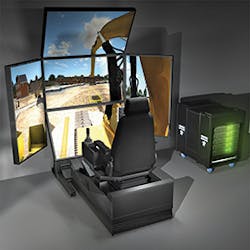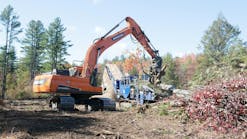Practice does make perfect. But the kind of practice you’re doing can make a huge difference. I’ve been playing golf since I was in grade school, but growing up in the Midwest meant the golf season usually came to an abrupt halt when the temperatures hit below 50-degrees F. For those of us who love the game, five to six months of not swinging a club and hitting a ball at full speed can be torture. And then there are those initial days of spring that we would have to spend shaking off the rust and finding our game again.
One winter, a local indoor racquetball court put up a golf simulator. Eureka! We were playing golf, indoors, in the winter! You could hit drives and fairway shots and chips, all on a virtual golf course. The way it worked was, you would hit your ball off of a patch of artificial turf into a wall-size projector screen that showed a life-size view of the fairway. The golf ball would hit the screen and your virtual ball would show up on the screen at the point of impact and soar down the virtual fairway. The simulator would calculate where the ball would end up using the speed and trajectory of the impact. We would play entire rounds of golf through the cold winter months. There was no rust to shake off when spring finally arrived, and our games were as sharp as our last outdoor round the previous year.
You Can’t Ignore the Benefits
In February 2014, Cipta Kridatama, one of Indonesia’s leading mining contractors, improved haul truck fuel efficiency by 6.9% by using simulation training. The contractor earned Immersive Technologies’ “Global Business Improvement Award.” The award is the highest recognition in the industry for mining companies using simulation for operator training, recognizing the achievements of mine sites focused on improving operational safety, efficiency, and productivity through strategic and focused training initiatives. The company was chosen out of more than 250 other global mining operations in 35 countries.
While presenting at a recent Immersive Technologies users group, Gemilang Adi Perdana said, “With commodity prices going down, like many sites, we are looking at ways to cut costs, and fuel consumption was identified as a problem area. We were over budget nearly 10,000 liters per month at one site and identified the contributors affecting fuel consumption. Operator skill level was the focus of the fuel efficiency efforts.”
The company collected the fuel records of 30 of its haul truck operators over a one-month period. It found that 18 of the 30 were over the budgeted liters-per-hour consumption. So, Citka Kridatama put all of the operators through simulation training to first establish a baseline. Evaluation and training then took place, followed by a simulator remeasurement. Once the operators passed the remeasurement, they were put back into the field. Finally, one month after being put back into the field, the operators were measured again for retention.
When the presimulation fuel records were compared with the post-simulation training fuel records, there was an improvement of 6.3% in one month. Onsite fuel usage went down each month thereafter, with the last reported usage showing a 6.9% overall improvement. The site is now operating 5.8% below the budgeted liters per hour of fuel consumption. “Production time was not affected with these improvements and, we believe, with a conservative estimate, we can save $500,000 per year through this training initiative,” Perdana said.
Operator training using Immersive Technologies’ Advanced Equipment Simulators reduced haul truck fuel consumption by 6.9% in five months. As an added benefit, since the haul trucks have a standard refueling schedule, and with tanks being more full, a secondary improvement was also calculated because refueling would take less time, leading to an increase in production time. The fuel efficiency initiative revealed unique insights into how small changes in operator behavior can affect cost savings through burning less fuel.
The technology driving these results has been embedded in the latest release of Immersive Technologies’ leading range of Advanced Equipment Simulators and is designed to enhance the way mining equipment operators learn to work in a productive manner. That includes eliminating behaviors that are linked to excess fuel consumption.
Immersive Technologies is also providing simulator-training solutions to help a Mexican Komatsu machinery dealer reduce maintenance costs and increase machine time for customers. The dealer, Road Machinery (of the MITSUI Group), is using simulator-based machine operator training at its recently inaugurated training center in Saltillo, Coahuila. The PRO3-B Advanced Equipment Simulator is self-contained and can be moved easily between locations. That kind of mobility allows Road Machinery to offer training at the training center and some customer sites.
Here are some of the average numbers from Immersive Technologies:
- 62.2% reduction in brake abuse
- 69.8% reduction in abusive shifting
- 54.5% reduction in engine overspeeds
- 10.4% increase in tire life
- 6.9% reduction in fuel consumption
Manuel Felix, vice president of operations for Road Machinery, says, “Being able to offer training with the type of proven results delivered by Immersive Technologies ensures our customers get the best return on investment.”
David Anderson, Immersive Technologies’ executive vice president, says, “Equipment performance and machine uptime are critical business drivers for all mine operations and original equipment manufacturers. The level of fidelity our simulators deliver will allow Road Machinery to partner with customers on continuous improvement projects, utilizing mine site data to determine targeted objectives and identify business and operational improvement opportunities.”
The mining equipment operator work force in Saudi Arabia will now be developed with the help of simulation-based training. It’s the largest mining simulation investment in history to be delivered by Immersive Technologies. Ma’aden, the largest mining company is Saudi Arabia, will use the simulators to address one of the biggest challenges faced by the kingdom. That challenge is the development of a skilled work force to support the expansion of mining.
Through a partnership of Immersive Technologies, Missouri S&T, and Ma’aden, hundreds of mining operators will be trained every year at Saudi Arabia’s first specialist training institute for the mining industry. Missouri S&T is a longtime customer of Immersive Technologies. It signed an agreement with Saudi Mining Polytechnic, which was originally established by Ma’aden and the Technical Vocational Training Corp. of Saudi Arabia, to provide mining training programs. It will be using Immersive Technologies simulators in its training programs.
Samuel Frimpong is the chair of Missouri S&T’s Mining and Nuclear Engineering Department. “Simulators from Immersive Technologies will play an important role in helping Missouri S&T deliver a world class training program for Saudi Mining Polytechnic in Arar, Saudi Arabia,” he says, calling it an excellent opportunity to shape the direction of the mining industry in Saudi Arabia through this work force development.
The investment includes seven Advanced Equipment Simulators and 18 simulator modules (conversion kits) for both surface and underground hard-rock mining.
More on the Plus Side
A good amount of the simulators in the field can track and keep records of an operator’s performance. Simulators track hundreds of metrics, such as time, usage, speed of operator, amount of material moved, and even the operator’s overall productivity, just to name a few. Afterwards, you get a report the trainer or operator can save to track performance throughout training.
Simulators are safe. They allow you the ability to make mistakes, as opposed to being in a real machine and potentially damaging it, costing the company thousands of dollars and putting the operator, or other people, in harm’s way. After a mistake, the trainer can immediately explain what the operator did wrong and how to correct the mistake, and then have the operator practice until mastered.
Another huge benefit is that of becoming familiar with the controls. Operators and students can learn them quickly and safely, without taking the machine out of production or wasting money on fuel.
The latest simulators from Caterpillar have all of these benefits. Cat Simulators has 13 models in its product line, with several that are specific to construction. The prices of the simulators depend on what type of package is selected and how many simulators are purchased. A single simulator can range from $30,000 to $50,000. Add-on training packages have also been developed for certain models.
Each Cat Simulator system comes with a steel hardware frame, adjustable seat, controls, and pedals that are specific to the machine that’s being simulated. It has a computer and component box, monitor stand, and large monitor, plus simulation software and SimU Campus records management software. The records management software records and reports the results of each simulation session so instructors, operators, and administration can track the operator’s progress.
Each simulator features simulation software with unique training exercises that cover applications specific to the machine being simulated. For example, the Hydraulic Excavator simulator teaches the operator to dig a trench and set a trench box. The M-Series Motor Grader teaches the operator how to perform rough and finish grading, and V-ditching, among other exercises.
Some systems use a front-and-back monitor to better convey the operator experience. Some systems can be equipped with a motion platform that allows users to feel movement and vibration when the simulated machine is running. By adding a motion platform, users will not only gain the knowledge and skills needed for controls and applications, they will also learn how to make the precision movements necessary to increase productivity, by getting used to tipping points on machines.
Many of the Cat simulator systems also come with an eBook that explains the purpose of each exercise, sets the expectations for operator performance, and shows how-to images and video samples of the proper way to conduct the exercise. It teaches safety, offers operator tips, and more. All books feature extra information specific to the machines, like working on slopes, soil chart, work tool attachments, and ditch types.
Cat Simulators list numerous reasons why clients will buy a simulator:
- It’s the safest way to train operators with hands-on experience.
- It reduces maintenance issues.
- Training more efficient operators increases production.
- Fuel costs are lowered.
- It’s a screening tool for mining operations.
- It reduces safety incidents.
- Training is consistent by using the same procedure every time.
Granted, there will always be some objections to the use of simulators. Certain instructors believe in training on the actual machines only, while others think of simulators as video games or toys. Price can be an issue for some. In regard to the cost, customers need to understand the value simulators bring, or all they will see is a price tag. Look at it this way”¦the alleviation of safety fines, the identification of faulty parts, the reduction of fuel consumption, the advantage of not having to take a machine out of production in order to train, and the reduction of the time it takes to train an operator can all be factored into the return on investment. Also, the cost of developing 3D software, along with the engineering necessary to match the training exercises to real-world applications is expensive. And as for the misconception of simulators being games”¦they are considered to be “serious games,” meaning they are used for training or education-definitely not the characteristics of a traditional video game. Cat simulators are developed with Caterpillar subject-matter experts, to make sure that the most apppropriate techniques and procedures are used.
There are a couple of other things to put in the “plus” column for simulators. One is mobility. Tom Whitworth, an account manager with Cat Simulators, says, “One of the great things we’ve seen in the construction industry is that large companies may have multiple locations, or job sites, all over the place. Some companies will outfit trailers as mobile labs. The trailer can then be moved from location to location easily without forcing everyone to go to one location that could be hundreds of miles away.”
Another advantage is that of being able to evaluate an operator even before that person is ever hired. According to Whitworth, “Lately, we’ve been seeing more and more companies using simulators for competency examinations and pre-hire screening. There are a lot of operators that may claim to be a good operator, but a few minutes in a simulator and the hiring or training manager can really tell if they’ve ever been in the seat of an excavator or dozer. This drastically cuts down on the costs that may be associated with making a bad hiring decision.”
Simlog is based in Montreal, QC. The company started selling its training simulation technology in 1999, technology that was developed at CRIM, one of Canada’s leading research institutes. The company name is a combination of the words simulation and logiciel, which is the French word for software.
Paul Freedman, the founder and president of Simlog, says the company now has customers in 60 countries around the world. About 60% of them are training service providers. Focusing on North America, the training service providers are primarily train-to-work programs at community colleges, private vocational training schools, and apprenticeship programs of the International Union of Operating Engineers. The focus of these programs is to get the new operators ready for training on the actual heavy equipment.
“But in this same training-service-provider category, we also count as customers a growing number of high schools that have embraced simulation to promote career awareness and provide skills exploration,” says Freedman, “where the focus is letting younger people experience what it would be like to operate heavy equipment as a career. After all, no one is going to let a 16-year-old climb into the cab of a real excavator just to see if this is something he could do and have fun doing.”
The other 40% of Simlog’s customers are owner/operators. Most of which are contractors, municipalities, counties, etc. These venues focus on a couple of things. You can double-check the skills of potential new operators, as opposed to finding out what happens at a first job site. The simulators are also used as tools to promote from within your organization. It gives those employees the opportunity to learn new skills to earn a higher wage.
According to Freedman, when you take into consideration the rising costs of putting real equipment to work under the supervision of a qualified instructor, the damage and downtime of the real equipment caused by mistakes of inexperience, and the risk of possible injury, simulation wins people over when it provides enough training help at a low enough price.
But even after being in business for more than 15 years, Simlog finds that the idea of using simulators to train heavy equipment operators is still a new idea to a lot of people. “And even today, over 50% of Simlog’s revenue is from people who’ve never had a simulator before,” Freedman says. Integrating a simulator into a training program would involve “making room” for the simulator-based step among the “class time” with an instructor and “seat time” at the controls of real equipment.
Volvo believes its simulators are a little more complicated than most. Wade Turlington, says the company has a full-motion hydraulic platform that costs $60,000″“$80,000. Turlington is director of the customer center and sales training for Volvo. A lot of smaller technical schools use Volvo simulators. They’re extremely useful when students are trying to achieve their safety or PPE requirements, and the annual accumulation of simulator hours can provide the students with metrics they simply cannot get from the real machine.
“Our simulation student manager system allows us to track performance and make suggestions on how to achieve better results,” Turlington says. “Also, it can print out a report. We want to avoid the appearance of Big Brother to experienced operators.”
Quebec City, QC, has two Volvo construction simulators as well as a fire truck, a police car, and an ambulance simulator. An instructor controls three screens in order to make changes to different conditions. The city actually sells simulator time to other organizations and businesses, which can bolster a business model.
Deere to Their Hearts
Stuart Leitch is the director of trades and technical programming at Portage College in Lac La Biche, AB. He says the college bought 12 John Deere simulators three years ago. The simulators of motor graders, dozers, and excavators are housed in a completely mobile 40-foot trailer, which includes a generator for powering the units. They’re used extensively as part of the college’s equipment operator training program. As part of the program, all students have to put in 40 hours on the simulators before getting into the real equipment. The training course for heavy-equipment operator involves a total of 580 hours over a 14- to 16-week period, 110 hours of which are in the classroom and the rest is practical.
Leitch says, “John Deere offers the best simulators and technical support for their particular purposes. Moreover, the cost savings of not having to operate the actual heavy equipment-it amounts to roughly 10% fuel savings every year, enough to buy a new simulator. The simulators really pay for themselves.”
Of the approximately 1,000 students per year, 60 are there for the heavy-equipment operator training program, and nearly all the rest are from the community at large, or from high schools, for three-hour training. And in the case of industry people”¦the simulators are being used as a screening tool.
In 2007, John Deere started an online operator-training program that eventually included the use of its simulators. Five simulators were used to train in the operation of four models: track dozer, motor grader, loader, and backhoe. A customer advocacy group made up of programmatic instruction designers and skilled operators began with asking “What do you want?” in the development of eight to 10 training lessons.
Jandi Ludin started as a curriculum developer for online operator courses at John Deere more than three years ago. She’s now a senior instructional designer and developer. “Operator training is designed to present basic understandings of machines, walk-arounds, checking fluids, basic instructions developed for in-house use by John Deere employees,” Ludin says. “Initially, it was a required course for Deere employees before they were allowed to get on machines, but over time the program was expanded to include outside students as well. It was a blended training approach combining the online curricula, simulators, and finally actual machines with trainer instructors to certify students as being proficient in the type of equipment.”
As the program evolved and grew, low-cost motion platform bases-providing forward-, back-, left-, and right-motion and work with all of the simulators-were added to the package. The way Deere looks at it, simulators are for training rather than as a profit center. That’s why the company concentrates on keeping the equipment affordable.
Even so, John Deere doesn’t ignore what it considers to be its principal markets. Those being community colleges (such as North Carolina Wake Tech Community College and its heavy-equipment technology training program), construction trade unions, and even the US military. The training program at Fort Leonard Wood, MO, has 30 simulators in what is referred to as a “crawl, walk, run” training program.
The company is also keeping current with new and developing technologies. For example, a Topcon grade-control system has been incorporated into the crawler-dozer simulator. Adding machine-control systems for the motor grader and excavator simulators is being considered. Also being considered is the incorporation of Trimble and Leica systems.
Another principal market would be the International Union of Equipment Operating Engineers, which is based in Washington, DC. The union offers an operating engineers certification program that includes heavy-equipment operator training. It has more than 1,000 full- and part-time instructors at various locales around the country, and many of them use simulators as part of their curriculum. In fact, Union 50 in Chicago has an entire room set up devoted to simulators.
If cost is of concern, John Deere offers a simulator rental program through its dealers to assist their customers. In that situation, the costs can range from $10,000 to $20,000, with an additional $10,000 for motion base.



